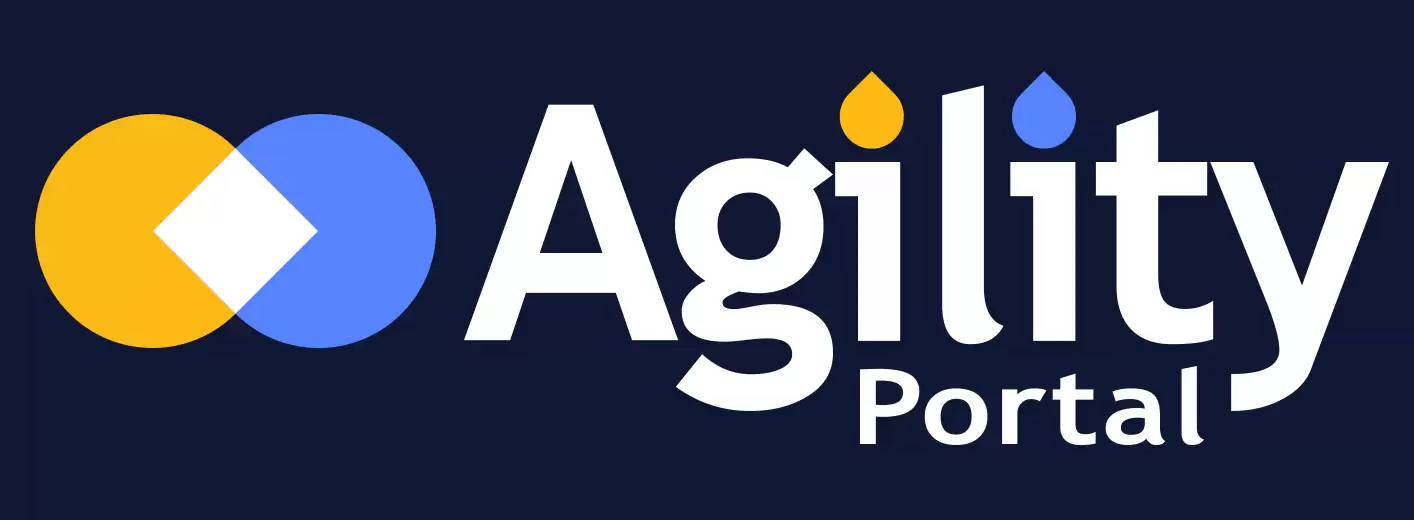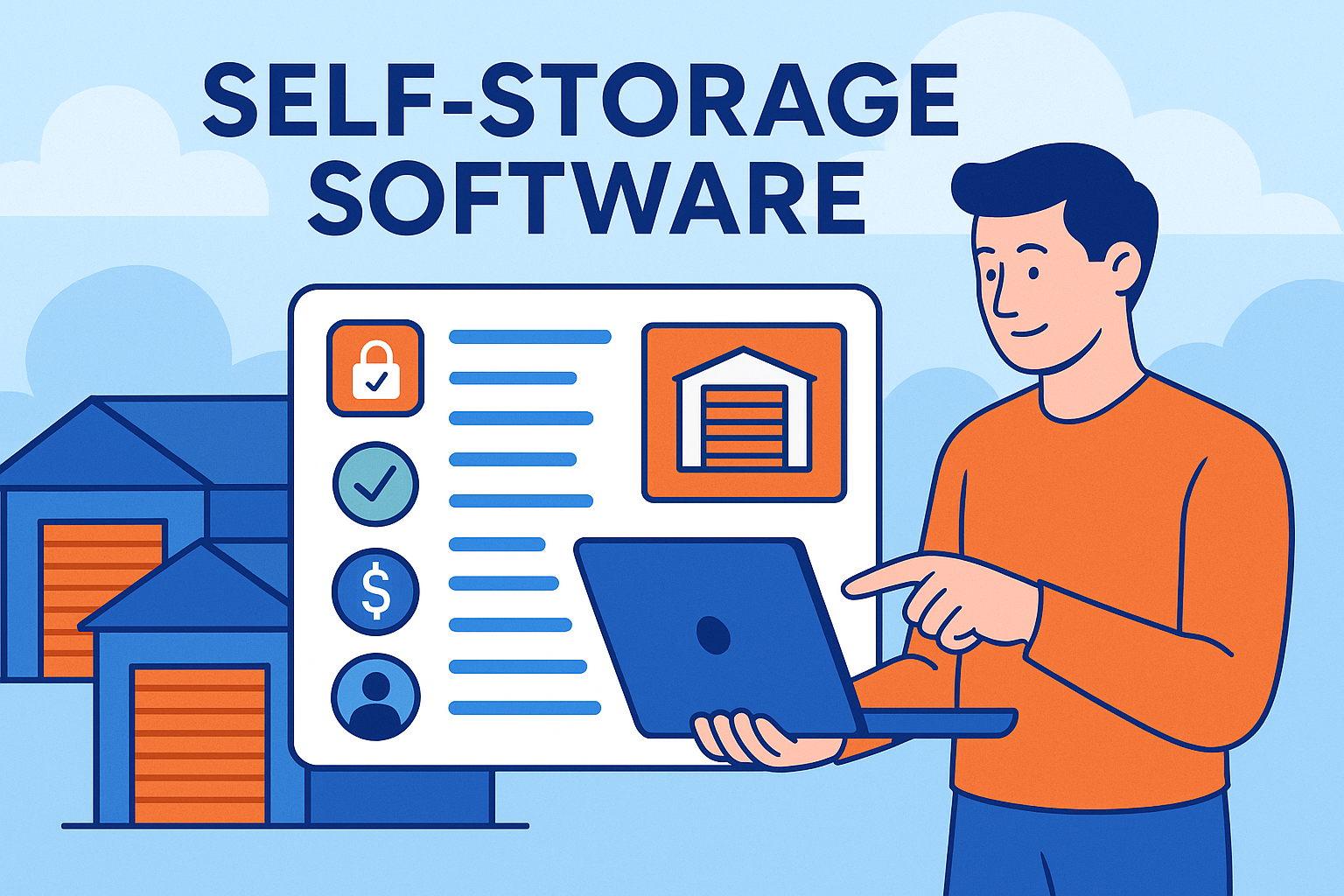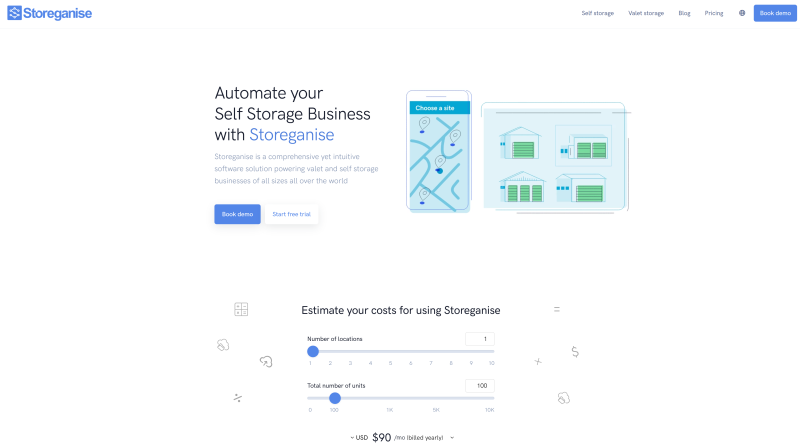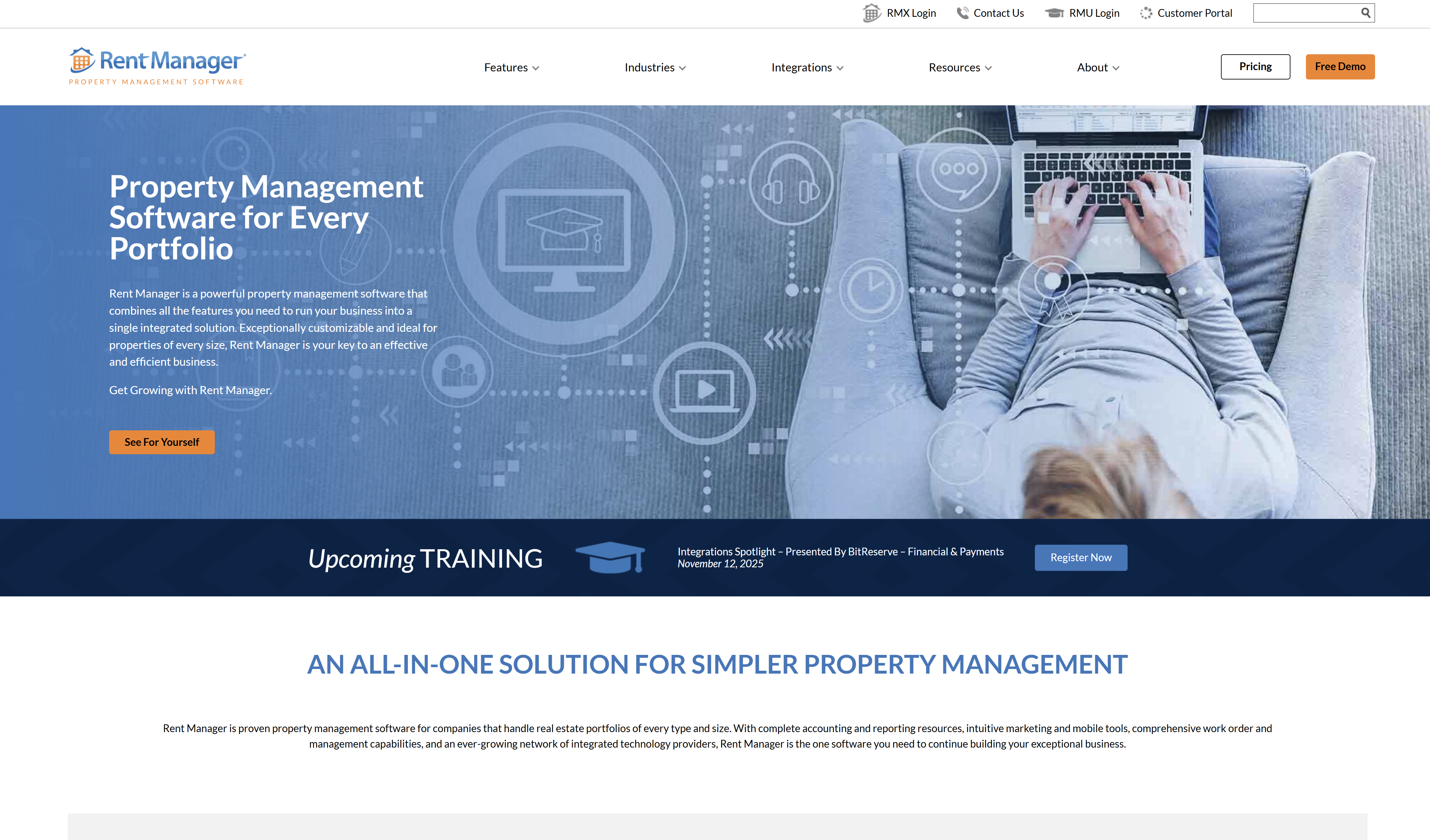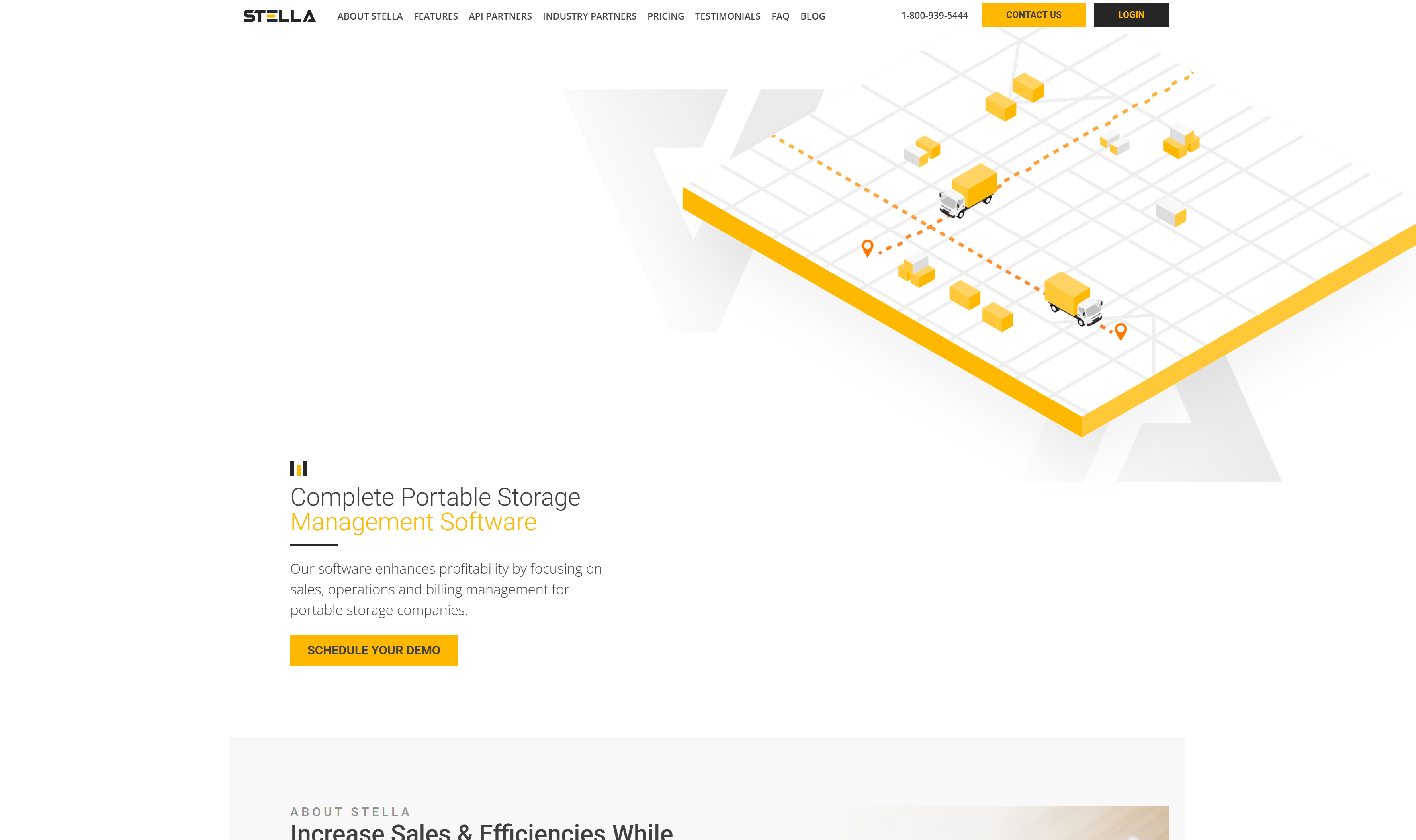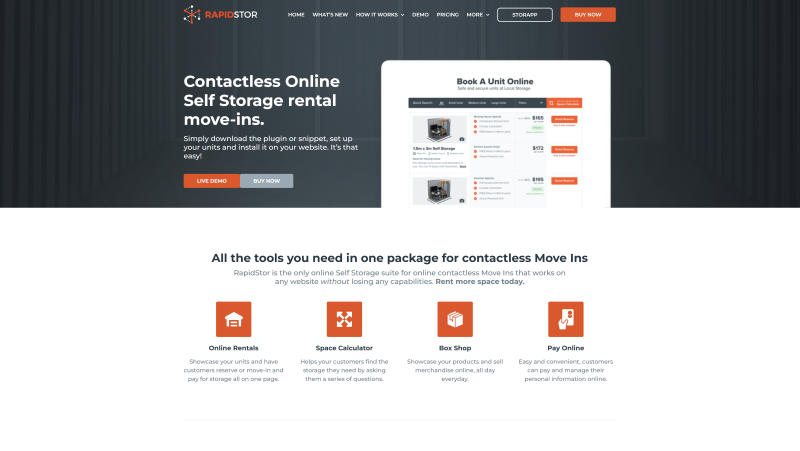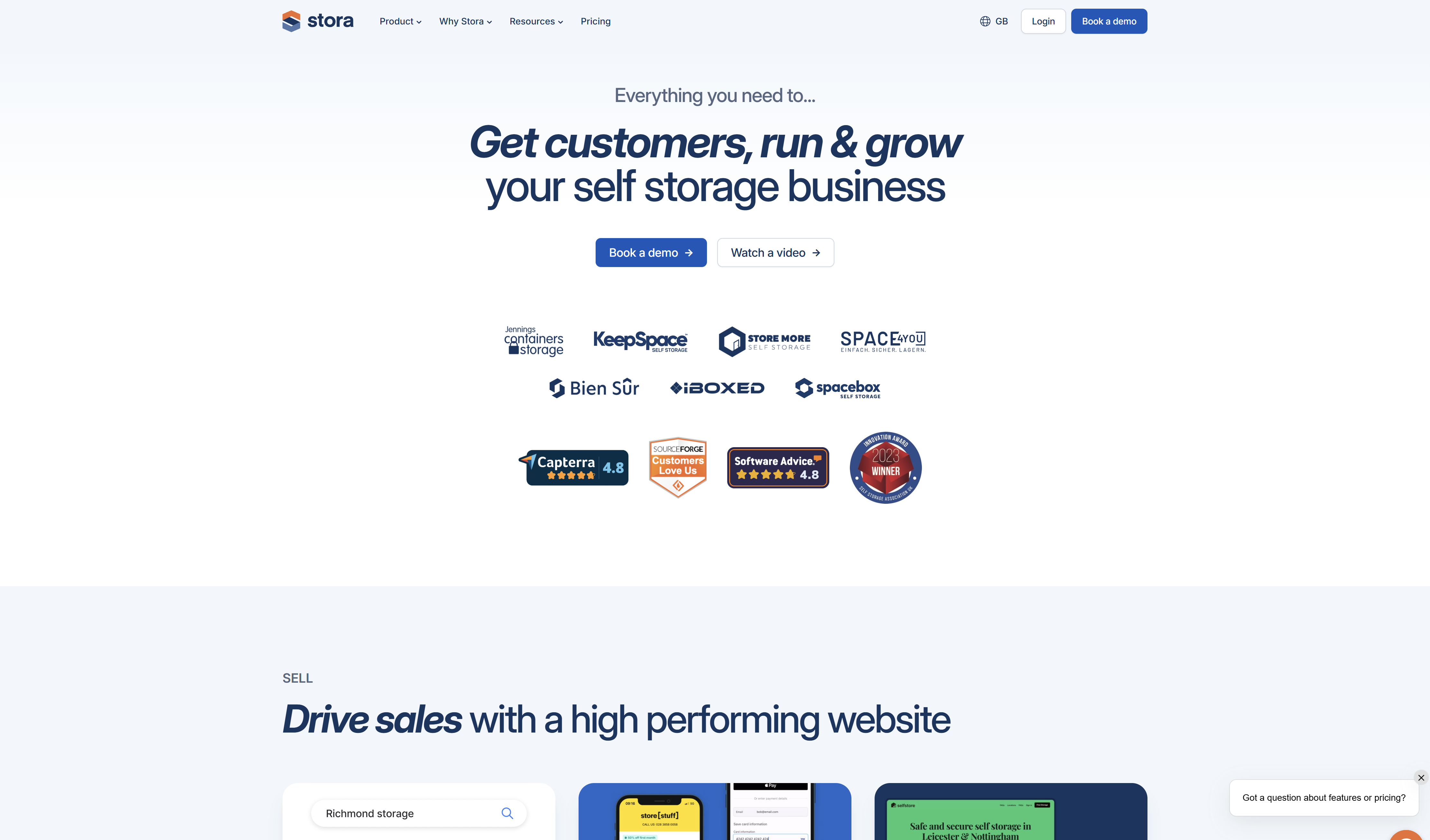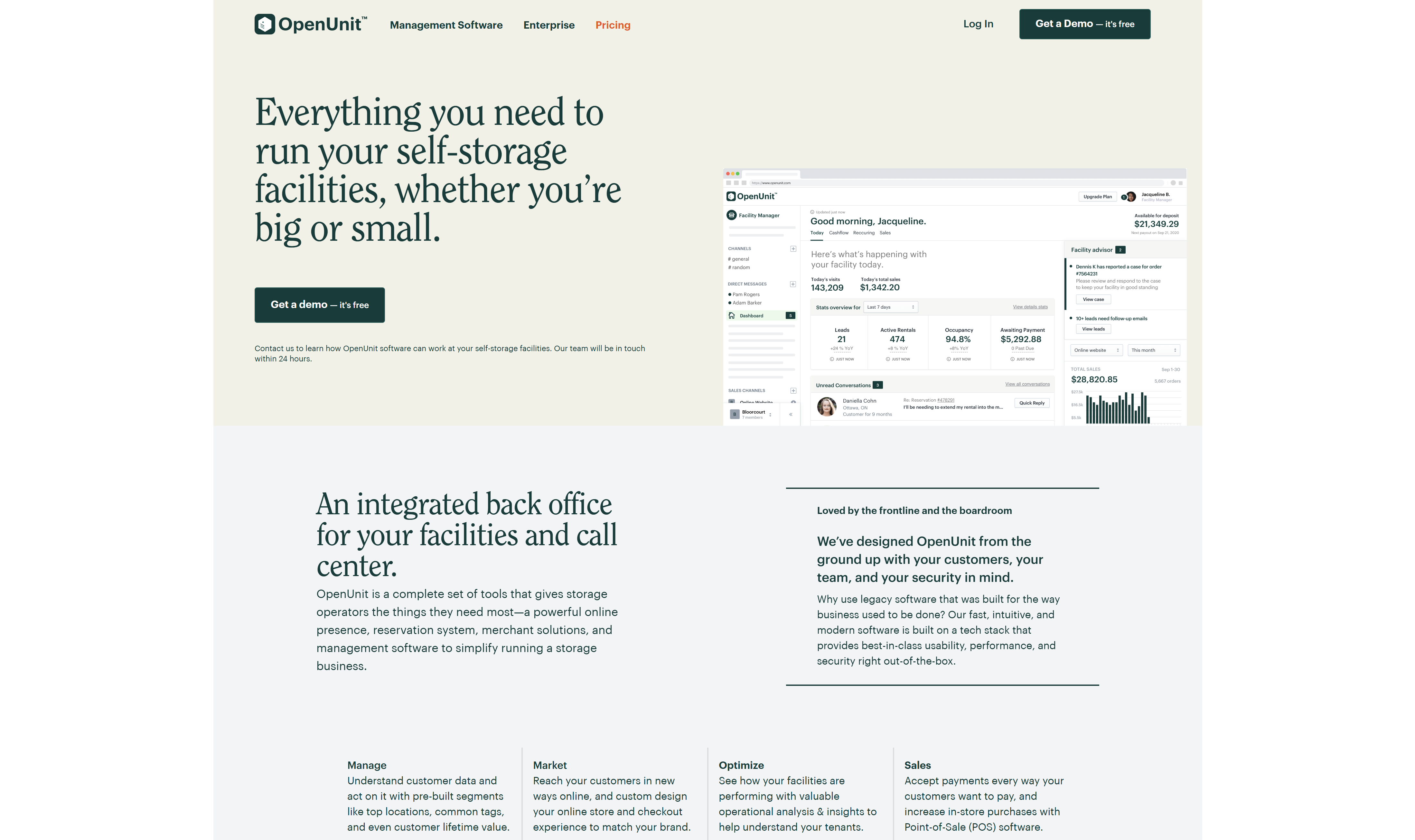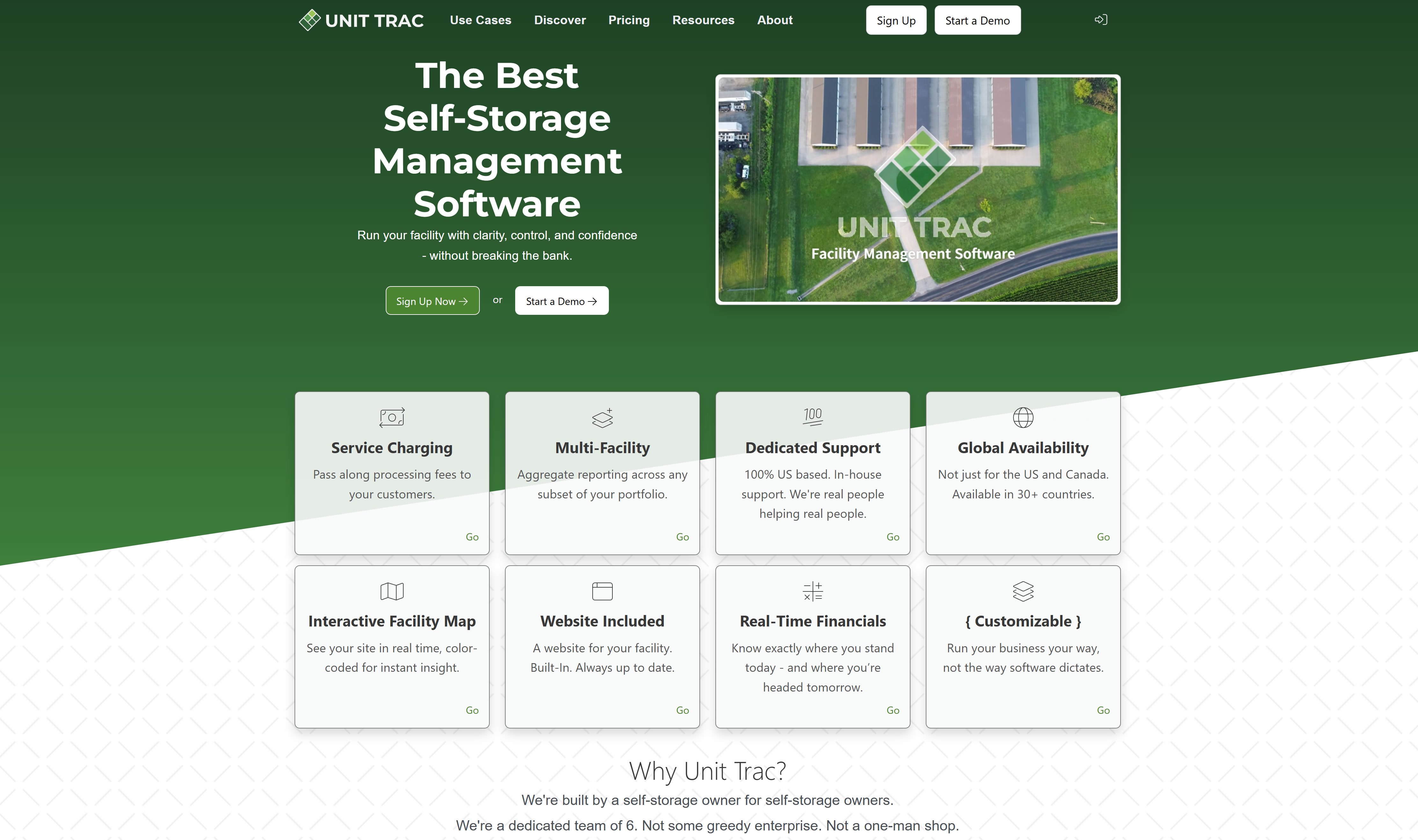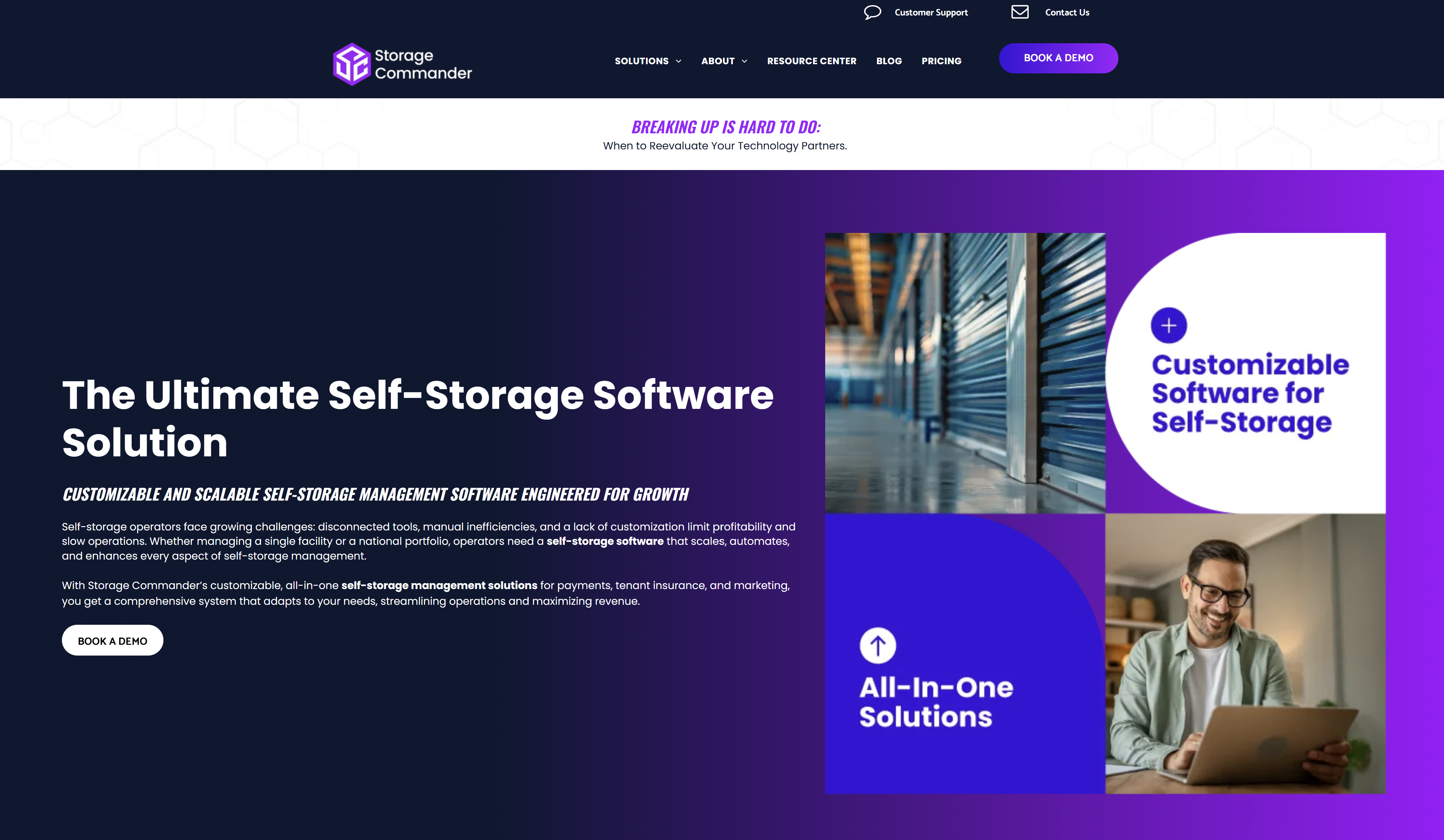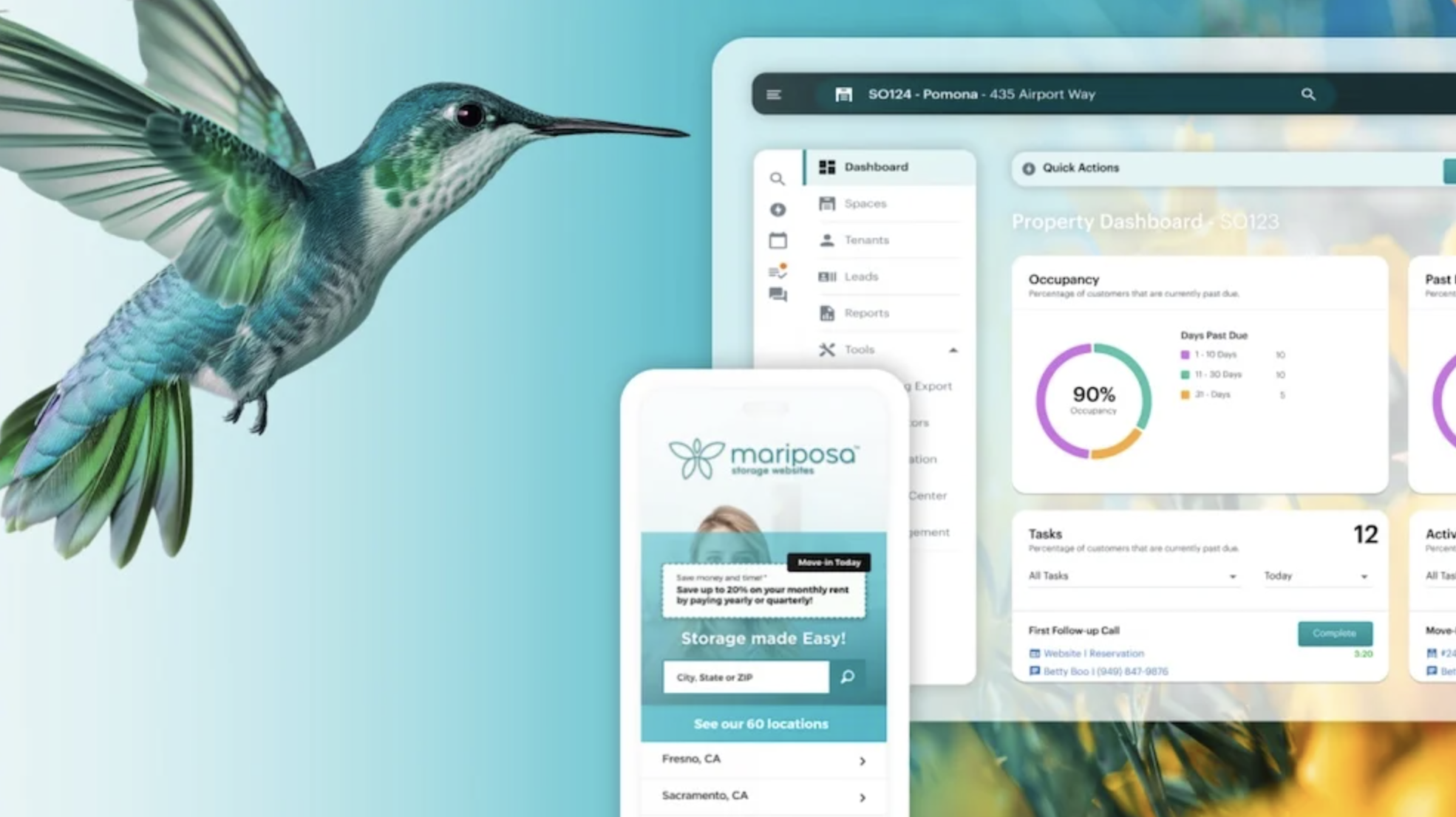Insight Blog
Agility’s perspectives on transforming the employee's experience throughout remote transformation using connected enterprise tools.
36 minutes reading time
(7105 words)
How Self-Storage Software Is Transforming Facility Management in 2025 (And Why You’ll Love the Results)
How Self-Storage Software Is Transforming Facility Management in 2025 (And Why You’ll Love the Results)
Discover how self-storage software is transforming facility management in 2025 with automation, analytics, and contactless customer experiences.
If you're in the storage business, you've probably noticed how fast things are changing.
Gone are the days of paper contracts, manual invoices, and "call us to reserve a unit."
In 2025, self-storage software is doing the heavy lifting—automating bookings, managing payments, and even handling tenant access without anyone setting foot in the office.
The industry is evolving fast.
According to recent market reports, the global self-storage management software market is growing at nearly 10% year-over-year, driven by the demand for contactless rentals and smarter facility management tools.
Operators are now focusing less on daily admin tasks and more on growth, customer experience, and profitability.
That's where the new wave of platforms comes in.
In this article, we'll walk through 10 game-changing self-storage software tools that are transforming facility management in 2025—from fully automated systems to flexible, cloud-based platforms built for modern operators.
Why Self-Storage Software Matters in 2025
Let's be honest — managing a storage facility isn't what it used to be.
Between juggling bookings, processing payments, and keeping track of who's renting which unit, even a small operation can start to feel like a full-time tech job.
That's exactly why self storage software for small business has become a must-have rather than a nice-to-have in 2025.
Modern platforms like Stora Self Storage are proving that automation can simplify just about everything.
With tools for online booking, e-signatures, and integrated payment processing, operators can focus on running their business instead of fighting with spreadsheets or phone calls.
These solutions give tenants the convenience they expect — think instant move-ins, 24/7 access, and real-time availability — while giving owners total visibility across every unit and customer interaction.
The market data backs it up.
According to Mordor Intelligence, the self-storage management software industry is seeing record growth as facilities move away from manual systems toward connected, cloud-based platforms. What's fueling that shift? Time savings, reduced operational costs, and better customer satisfaction scores.
Of course, one big question most owners ask first is: What does self storage software cost?
The good news is there's something for every budget. Many vendors now offer flexible pricing based on the number of units, locations, or features you need. Smaller operators can start with affordable monthly subscriptions, while large chains often go for enterprise packages with deeper integrations and analytics.
Whether you manage one site or fifty, the goal is the same — find software that automates the repetitive stuff, keeps data secure, and scales with your growth.
In short, the right self-storage software isn't just a management tool anymore — it's the backbone of a modern, profitable storage business.
What to Look for in a Modern Self-Storage Platform
So, how do you actually choose the best self storage software for your business?
With dozens of tools out there promising automation, smart dashboards, and seamless integrations, it can be tricky to know what really matters.
Let's break down the features that make a real difference — whether you're running one facility or managing multiple sites.
Cloud-Based Architecture
Cloud-based design is the heartbeat of modern self storage software. Instead of relying on bulky servers or single-location desktops, everything runs securely online — giving owners, managers, and even field staff access from anywhere.
Imagine checking occupancy, approving a booking, or updating a tenant's payment status right from your phone. That flexibility makes cloud systems ideal for small businesses and growing operators managing multiple sites.
The benefits go beyond convenience.
Cloud solutions handle automatic backups, security updates, and real-time data syncing — meaning you're never dealing with version conflicts or lost files again. Plus, it's scalable: as your facility grows, your system simply expands without expensive IT hardware or maintenance.
When comparing options, factor in self storage software cost over time.
While cloud systems usually come with a monthly subscription, they eliminate many hidden expenses like server maintenance, manual upgrades, and downtime losses.
In short, cloud-based architecture gives you speed, mobility, and peace of mind — all while saving time and long-term costs.
Automation That Saves You Hours
Automation is the secret weapon behind the best self storage software. Instead of spending hours chasing payments or manually entering customer details, automated workflows handle everything — from issuing invoices to sending reminders and granting access codes.
Think of it as a digital assistant that never takes a day off.
For self storage managers, automation reduces human error, improves cash flow consistency, and ensures nothing slips through the cracks. Rent renewals happen on schedule, late-fee reminders go out automatically, and even gate access can be triggered without manual input.
The result?
Happier tenants, fewer headaches, and smoother operations.
For small businesses, automation means being able to compete with large, enterprise operators. You can manage multiple facilities or hundreds of units with a leaner team — cutting down administrative costs and time wasted on repetitive tasks.
While automation tools can influence overall self storage software cost, they often pay for themselves within months by saving labor hours and preventing costly mistakes.
Simply put, automation transforms your storage business from reactive to proactive — freeing you up to focus on growth, not paperwork.
Online Reservations & Digital Payments
Modern customers expect convenience.
The best platforms let tenants book units online, sign contracts digitally, and pay on their phones. That's the kind of smooth, contactless experience that wins repeat business.
Data Analytics & Dashboards
If you can't measure it, you can't improve it — and that's where analytics come in.
The best self storage software now includes built-in dashboards that visualize everything from occupancy trends to revenue forecasts. Instead of digging through spreadsheets, you see key performance metrics at a glance.
For a self storage manager, this data is gold. You can identify underperforming units, spot seasonal trends, and adjust pricing dynamically. Analytics also highlight which marketing channels bring in the most tenants, helping you spend smarter.
Dashboards also improve transparency across teams — everyone from site staff to accounting can access real-time data from one source of truth.
In short, analytics don't just report what's happening — they guide your next move. When you understand your facility's data, every decision becomes strategic rather than reactive.
Integrations with Accounting & Payment Processors
The best business tools are the ones that talk to each other — and integrations make that possible.
Modern self storage software connects seamlessly with accounting systems like QuickBooks or Xero and payment gateways such as Stripe, Square, or PayPal.
For self storage managers, this means no more double-entry errors or switching between systems. When a tenant makes a payment, it's automatically recorded in your books. Reports stay accurate, and reconciliation becomes effortless.
This kind of automation is especially valuable for small businesses, where every minute (and dollar) counts. Integrated systems reduce admin time, prevent costly accounting mistakes, and give you a real-time snapshot of your financial health.
Although integrations can affect self storage software cost, the payoff is enormous — fewer manual processes, cleaner data, and faster month-end closes.
Plus, having connected systems improves your ability to forecast revenue and manage cash flow with confidence.
In short, integrations keep your business lean, efficient, and financially transparent — which is exactly what modern operators need to scale successfully.
Multi-Currency & Multi-Facility Support
If you're expanding globally or managing multiple sites, make sure your software supports multiple currencies and standardized processes across locations.
Don't overlook self storage software cost when comparing options. Some vendors charge per facility or per unit, while others offer flat-rate subscriptions. It's worth reviewing your growth plans before signing up — the cheapest option now might not scale well later.
At the end of the day, the best self storage software isn't just about features — it's about how well it fits your workflow and helps your business grow without adding extra stress
Read this article: : Top 6 AI-Powered Project Management Tools To Use In 2023
Comparison Table - Top 10 Self-Storage Software Platforms for 2025
This roundup draws from the latest vendor listings, curated software comparisons, and trusted buying guides — focusing on platforms that real operators rely on every day.
We paid close attention to solutions that make online booking effortless, automate key workflows, and integrate seamlessly with other tools.
Extra credit went to systems that simplify Climate-Controlled Storage management through clear unit types, transparent pricing, and effective tenant communication features.
The list highlights a mix of global innovators and standout regional leaders frequently recognized in expert reviews and industry roundups.
| Software | Key Advantages | Best For | Unique Feature |
| Storeganise | Branded tenant experience, full automation, open API, multi-currency, global access | Operators seeking modern, contactless rental flows with global scalability | 97% autonomous operation capability |
| Rent Manager | Flexible workflows, multi-site reporting, integrated accounting, strong tenant comms | Established operators managing multiple properties | Customizable automation and accounting integration |
| Stella | Portable storage specialization, built-in CRM, optimized sales tracking | Operators managing portable or container-based storage | Designed specifically for containerized storage models |
| RapidStor | Website-embedded 24/7 bookings, transparent pricing, SiteLink integration | Operators prioritizing online booking experiences | Embedded on facility websites for instant move-ins |
| StoRegister | Multi-storage-type support, advanced analytics, 3D sitemap, mobile access | Multi-facility or diverse storage operators | 3D sitemap visualization dashboard |
| OpenUnit | Modern tech stack, customer analytics, POS integration, customizable storefronts | Forward-thinking operators with advanced analytics needs | Lifetime value and customer segmentation tracking |
| Unit Trac | Lean functionality, practical automation, device-agnostic | Operators seeking simple, fast workflows | Developed by storage operators for storage operators |
| Storage Commander Cloud | Modern interface, quick onboarding, practical automation | Operators seeking modern design and rapid setup | End-to-end coverage for billing, comms, and reporting |
| WebSelfStorage | Integrated marketing, lead capture, tool consolidation, tiered pricing | Small to mid-sized facilities with limited IT resources | Combined operations + marketing management |
| Tenant Inc (Hummingbird) | Modern UX, open API, integrated ecosystem, active community | Operators seeking a continuously evolving all-in-one solution | Strong developer community with ongoing updates |
Top Self Storage Management Software Tools
When exploring the best software for self-storage management, we looked closely at what really matters to operators — pricing flexibility, scalability, ease of integration, and an intuitive user experience.
These are the features that make a difference in daily operations and long-term growth.
Based on these criteria, we've highlighted the leading self-storage management software solutions for 2025, each offering a unique mix of automation, analytics, and customer-focused functionality to help facilities run more efficiently.
#1. Storeganise – Automation-First Design Leading the Industry
Storeganise stands out as one of the most advanced and automation-driven platforms in the self-storage industry.
Designed for both traditional and valet-style facilities, it empowers operators to run nearly autonomous businesses — with some reporting up to 97% automation levels.
From contactless bookings to automated billing and digital access, Storeganise helps streamline operations and elevate the tenant experience to a modern standard.
Top Features
Pros
Cons
Integrations
Seamless integrations with payment gateways, accounting platforms (like Xero and QuickBooks), insurance providers, and access control systems.
The open API allows developers to build custom connections to other business tools.
Support
24/7 online help center, responsive live chat, and email support.
Storeganise is known for its fast support response times and detailed onboarding resources, including training materials and setup guides.
Ratings & Reviews
Users frequently highlight Storeganise's ease of use, automation depth, and reliability as standout qualities
Pricing
Pricing is based on the number of units and selected features.
While Storeganise sits in the mid-to-premium price range, operators find the automation and time savings deliver strong ROI. A free demo and trial are available for new users.
#2. Rent Manager – Flexible Property Management with a Self-Storage Focus
Rent Manager bridges the gap between traditional property management and the unique needs of self-storage operations.
Originally designed for multi-unit property portfolios, it has evolved into a robust platform used by storage operators who need advanced reporting, built-in accounting, and total workflow control.
Whether you're managing a handful of facilities or hundreds of units, Rent Manager helps centralize daily operations and maintain financial transparency across every site.
Top Features
Pros
Cons
Integrations
Rent Manager integrates smoothly with payment gateways, CRM systems, and document management tools.
It also supports API connections for custom solutions, ensuring compatibility with most existing business software.
Support
Offers live chat, phone, and email support, plus a detailed online knowledge base.
Users appreciate the U.S.-based support team and structured onboarding sessions that make implementation smoother.
Ratings & Reviews
Reviewers praise its strong financial tools and scalability, often describing Rent Manager as a "workhorse" for managing multi-site portfolios.
Pricing
Rent Manager uses a modular pricing model, letting businesses pay only for the features they need.
Pricing typically scales with the number of units and modules selected.
A free demo is available upon request, and the cost is considered mid-range for enterprise-grade software.
#3. Stella – Purpose-Built for Portable Storage Operations
Stella takes a unique approach to storage management by focusing specifically on portable and container-based storage operations.
Instead of retrofitting features from traditional facility software, Stella was designed from the ground up for businesses that deliver, track, and manage portable units at customer locations.
It's the go-to solution for operators who want full visibility of their containers, from dispatch to return, without juggling spreadsheets or manual tracking.
Top Features
Pros
Cons
Integrations
Stella integrates with popular accounting and communication tools, offering essential APIs for automation and syncing data.
While not as open-ended as enterprise systems, it supports key operational integrations needed for logistics-heavy storage businesses.
Support
Offers email and live chat support with responsive turnaround times.
The Stella team provides personalized onboarding sessions, particularly for businesses transitioning from manual processes.
Users appreciate the hands-on setup help and industry-specific training resources.
Ratings & Reviews
Users highlight Stella's niche focus, simplicity, and ability to improve coordination between sales and operations teams. It's especially valued by portable storage providers that need clear logistics visibility.
Pricing
Pricing is subscription-based, typically determined by the number of portable units and operational features required.
It's considered affordable for small to mid-sized storage businesses, with flexible monthly plans and optional add-ons for CRM and delivery tracking modules.
#4. RapidStor – Website-Embedded Contactless Booking Platform
RapidStor is all about making storage rentals as quick and seamless as possible.
Developed by self-storage industry experts, it focuses on website-embedded booking experiences that let customers reserve and move in instantly — no phone calls or manual forms required.
This contactless approach has made RapidStor a popular choice for operators across Australia, New Zealand, and the Asia-Pacific region, where transparency and convenience drive customer decisions.
Top Features
Pros
Cons
Integrations
Seamlessly integrates with SiteLink Web Edition for backend management, as well as with payment gateways and marketing platforms.
The embedded structure allows easy synchronization between your facility website and internal systems.
Support
RapidStor provides email, phone, and live support during regional business hours.
The company is known for its hands-on onboarding and responsive customer service, particularly for operators new to online booking automation.
Ratings & Reviews
Reviewers love RapidStor's reliability and how simple it makes the online rental process. Many mention noticeable improvements in lead conversions and fewer manual booking errors.
Pricing
Pricing follows a per-facility model, depending on the level of customization and integrations required.
RapidStor is considered cost-effective for small and mid-sized operators, with flexible monthly billing and quick setup times.
#5. StoRegister – Modern Cloud Platform with Multi-Facility Flexibility
StoRegister represents the next generation of cloud-based self-storage management software, offering flexibility for operators managing different storage types — from boxes and containers to vehicles and boats.
Its clean interface, modern dashboard, and advanced analytics make it a powerful all-in-one solution for businesses running multiple facilities or looking to expand their operations without adding technical complexity.
Built with scalability and mobility in mind, StoRegister allows managers to control everything from a central dashboard — whether on-site, at home, or on the go.
Top Features
Pros
Cons
Integrations
StoRegister connects with accounting tools, payment processors, and access control systems, ensuring a smooth flow of data across departments.
Its API support allows businesses to connect with additional third-party systems as they scale.
Support
Provides responsive customer service via email, chat, and onboarding sessions.
Users praise StoRegister's hands-on setup support and the clarity of its documentation, which simplifies migration from legacy systems.
Ratings & Reviews
Users often highlight its clean design, multi-facility control, and ease of navigation. Many mention that it significantly improves visibility and team coordination across large property portfolios.
Pricing
StoRegister uses a tiered subscription model, with pricing based on facility count, features, and storage type coverage.
It's considered mid-range in cost, offering solid value for operators that prioritize scalability and modern design.
#6. OpenUnit – Contemporary Architecture for Modern Operators
OpenUnit is built with a clean, modern tech stack that feels fast and flexible from day one.
It blends back-office control (inventory, billing, operations) with a polished online storefront so your brand looks sharp across the entire tenant journey.
Operators like the balance: powerful customer analytics and segmentation under the hood, plus simple tools for reservations, payments, and move-ins on the surface. If you want a future-ready platform that plays nicely with the rest of your stack, OpenUnit is a strong fit.
Top Features
Pros
Cons
Integrations
Connects with payment processors, accounting platforms, access control, and marketing tools.
An open, developer-friendly API supports custom workflows and data syncs to CRM/BI systems.
Support
Email and live support, onboarding assistance, and a concise knowledge base.
Implementation guidance is available for data migration and brand setup.
Ratings & Reviews
Consistently positive feedback on usability, speed, and analytics depth.
Users often highlight the polished UX and straightforward tenant experience. (Commonly rated highly on major software directories.)
Pricing
Subscription pricing that scales by features and footprint.
Positioned mid-market: affordable for single sites, flexible for multi-facility portfolios. Trials and demos typically available.
#7. Unit Trac – Lean Cloud Platform Emphasizing Essential Workflows
Unit Trac takes a "less is more" approach to self-storage management.
Built by operators for operators, it focuses on the core daily workflows that matter most — managing leases, collecting payments, tracking occupancy, and staying on top of maintenance.
Its cloud-based platform is lean, fast, and refreshingly simple, making it a great choice for businesses that want functionality without unnecessary complexity.
Top Features
Pros
Cons
Integrations
Integrates with leading payment processors and accounting tools for seamless billing.
While the integration ecosystem is smaller, it covers all essentials for managing operations efficiently.
Support
Offers responsive email support and detailed documentation for onboarding.
Users note that the support team's industry knowledge makes troubleshooting straightforward and fast.
Ratings & Reviews
Customers consistently praise Unit Trac's simplicity, ease of navigation, and reliability. Many highlight how quickly new staff can learn the system.
Pricing
Unit Trac provides a transparent, subscription-based pricing model tailored to facility size.
With affordable monthly rates and no hidden fees, it's considered one of the best-value options for small to mid-sized operators seeking dependable, no-frills functionality.
#8. Storage Commander Cloud – Modern Interface Paired with Practical Automation
Storage Commander Cloud combines a clean, modern design with practical automation tools that simplify everyday operations for storage facility managers.
It's built for real-world usability — fast to set up, easy to learn, and powerful enough to manage facilities of any size.
From online payments to tenant communications and performance reporting, it handles everything you'd expect from a modern self-storage management platform without the bloat or complexity.
Top Features
Pros
Cons
Integrations
Connects with payment gateways, accounting software (QuickBooks, Xero), and access control systems.
API access allows flexibility for businesses wanting to connect to CRMs or third-party marketing tools.
Support
24/7 online ticketing and weekday phone support.
Users frequently mention Storage Commander's friendly, knowledgeable support team and helpful onboarding webinars for new staff.
Ratings & Reviews
Users appreciate its reliability, ease of setup, and strong automation features. Many note that it's one of the most accessible tools for facilities upgrading from manual systems.
Pricing
Storage Commander Cloud uses a flexible monthly subscription model, with pricing based on the number of units and active locations.
It's considered mid-range in cost but offers excellent value for facilities seeking a balance between automation, usability, and support quality.
#9. WebSelfStorage – Consolidated Operations and Marketing Management
WebSelfStorage stands out for combining facility management and marketing tools in one unified platform. It's designed for operators who want simplicity and efficiency without switching between multiple systems.
From online rentals and lead capture to integrated payment processing and reporting, everything is handled inside a single, easy-to-navigate dashboard.
This all-in-one approach makes WebSelfStorage particularly appealing for small to mid-sized operators that need a cost-effective way to manage operations, customer interactions, and promotions all in one place.
Top Features
Pros
Cons
Integrations
Works with payment processors, accounting software, and digital marketing platforms.
Its API and partner ecosystem make it adaptable for operators who need light customization or integration with existing business tools.
Support
Offers email and phone-based support with access to an online knowledge base.
Users note that the support team is responsive and that setup is guided with clear, easy-to-follow onboarding steps.
Ratings & Reviews
Customers often mention its simplicity, reliability, and the convenience of having operations and marketing under one roof.
Pricing
WebSelfStorage follows a tiered pricing model, making it affordable for startups while offering more features as you scale.
It's considered budget-friendly, especially for facilities that want a unified system to manage both rentals and customer engagement.
10. Tenant Inc (Hummingbird) – Modern Ecosystem with Active Community Feedback
Tenant Inc, known for its flagship platform Hummingbird, takes a modern, ecosystem-based approach to self-storage management.
Rather than just offering standalone software, Tenant Inc provides a connected suite of tools — from online rentals and payment processing to marketing and protection plans — all unified under one platform.
What really sets it apart is its active operator community. Feedback from users directly shapes the roadmap, leading to constant updates and practical, real-world improvements.
Hummingbird is built for operators who value integration, scalability, and an open architecture that adapts as their business grows.
Top Features
Pros
Cons
Integrations
Supports deep integrations with marketing tools, CRMs, access control systems, and financial platforms.
The open API lets businesses connect custom apps or data pipelines for full ecosystem flexibility.
Support
Provides responsive email and chat support with onboarding specialists for new customers.
The Tenant Inc community forum is a major advantage, giving operators direct access to peer insights and product team interactions.
Ratings & Reviews
Users praise its modern design, frequent updates, and community-driven development model. Many report smoother integrations and better visibility across their storage portfolio.
Pricing
Tenant Inc follows a modular pricing model, allowing facilities to choose which ecosystem tools to activate — from Hummingbird property management to digital marketing or protection plans.
Pricing is mid-to-high tier, reflecting its enterprise-grade functionality and scalability.
Choosing the Right Storage Facility Software for Your Business
Running a storage facility involves a lot of moving parts — from managing tenants and tracking occupancy to handling payments and maintaining security.
That's where storage facility software steps in. Designed to simplify operations, these platforms bring everything together in one easy-to-use dashboard.
Modern self storage systems combine tools for online rentals, digital payments, access control, and unit tracking. Instead of juggling spreadsheets or relying on manual updates, you can automate your day-to-day tasks and keep everything running smoothly.
The best digital storage management tools help operators cut down on admin time, minimize errors, and deliver a better experience for tenants — all while giving you real-time visibility into your business.
Whether you manage one small facility or a growing network of sites, an automated storage platform can make life easier.
We compared several leading solutions based on functionality, pricing, ease of use, customer support, and integration options.
In this guide, you'll find our top picks — and practical tips to help you choose the right storage management software to match your facility's needs and growth plans.
Key Features to Consider Before Buying Storage Facility Software
Choosing the best software for self storage companies isn't just about flashy dashboards or fancy marketing claims — it's about finding a system that actually fits how you work.
Whether you're upgrading from spreadsheets or replacing an outdated program, keep these key features in mind before you commit.
- Cloud-Based Access - Look for a cloud-based self storage platform that lets you manage your business from anywhere. Cloud access means your data is always backed up, secure, and available — whether you're at the facility, at home, or on the road.
- Automated Workflows - The best automated facility management tools handle the routine stuff for you — like sending rent reminders, processing online payments, and updating occupancy. That saves you hours every week and keeps operations running smoothly even with a small team.
- Tenant Management System - A strong tenant management system is non-negotiable. It should store tenant info, manage digital leases, track late payments, and even issue automatic receipts. Think of it as your virtual front desk.
- Payment & Accounting Integration - Your storage platform should integrate easily with accounting tools like QuickBooks or Xero. This keeps your books clean and reduces manual data entry.
- Data Analytics & Reporting - Insight is everything. Look for dashboards that help you monitor occupancy, forecast revenue, and spot trends before they become problems.
- Scalability & Cost Efficiency - Finally, compare storage software pricing models. Some charge by unit or facility, while others offer all-inclusive plans. Make sure your choice can grow with your business without breaking your budget.
In short, great storage management software should feel like having an extra team member — one that never sleeps, never forgets, and always keeps your facility one step ahead.
Feature Comparison - How the Top 10 Self-Storage Software Platforms Stack Up
| Feature | Availability (Out of 10) | What It Means for Operators | Leading Examples |
| Online Rentals & E-Signatures | ✅ 10/10 (100%) | A must-have in 2025 — every platform supports 24/7 online bookings and digital lease signing. | Storeganise, RapidStor, OpenUnit |
| Integrated Payment Processing | ✅ 10/10 (100%) | All solutions include secure online payments — ensuring cash flow and less manual billing. | Rent Manager, Storage Commander Cloud |
| Mobile Access & Remote Management | ✅ 10/10 (100%) | Every provider offers mobile access; 6 excel with full mobile dashboards, 4 offer solid companion apps. | StoRegister, Tenant Inc (Hummingbird) |
| Multi-Site Management | ⚙️ 9/10 (90%) | Ideal for growing operators; only a few niche solutions focus on single-site setups. | Rent Manager, StoRegister, WebSelfStorage |
| Open API & Third-Party Integrations | ⚙️ 9/10 (90%) | Critical for flexibility — connects accounting, CRM, and marketing tools. | Storeganise, Tenant Inc, OpenUnit |
| Advanced Reporting Dashboards | ✅ 10/10 (100%) | All include analytics, but data depth and visualization quality vary. | StoRegister, Rent Manager |
| Automated Billing & Invoicing | ✅ 10/10 (100%) | Fully automated rent cycles and reminders are standard — no manual follow-ups needed. | Storeganise, Unit Trac |
| Tenant Self-Service Portal | ✅ 10/10 (100%) | Tenants can log in, view bills, update info, and make payments easily. | RapidStor, Storage Commander Cloud |
| Document & File Management | 📁 7/10 (70%) | Common in mid-market and enterprise tools; less focus in entry-level systems. | Rent Manager, OpenUnit |
| Built-In CRM & Lead Management | 💬 6/10 (60%) | Emerging trend — growing adoption for sales tracking and customer engagement. | Stella, OpenUnit, Tenant Inc |
What to Look for When Choosing the Best Software for Self-Storage Management
Finding the best software for self storage management isn't just about ticking boxes — it's about choosing a system that truly makes your day-to-day operations easier and your business more profitable.
The right storage facility software should handle the heavy lifting behind the scenes while giving you valuable insights that help you make smarter business decisions.
In 2025, operators expect far more than basic booking tools or spreadsheets.
Modern self storage management tools are designed to automate repetitive work, improve communication, and create a seamless experience for both staff and tenants.
Here are the key features you'll want to look for:
- Automated billing and payments to ensure rent collection runs on autopilot.
- Tenant portals that let customers manage their accounts, update details, and pay online.
- Access control integration with gate or door systems for secure, contactless entry.
- Unit inventory management to track availability in real time.
- Digital lease signing for quick, paperless move-ins.
- Maintenance request tracking so no issue goes unresolved.
- Reporting and analytics for data-driven decision-making.
- Mobile accessibility for managing operations on the go.
- Customization options to fit your unique workflows.
- Marketing and lead management tools to attract and convert new tenants.
- Integration capabilities to connect with your accounting, CRM, or payment systems.
When your software includes these features, everything clicks — operations run smoothly, customers stay happier, and your facility becomes more efficient and profitable.
Which Self-Storage Management Software Fits Your Business Best?
Selecting the right self-storage management software isn't about picking the most popular name — it's about finding a platform that aligns with how you run your facility.
Every storage operation is different, and your ideal solution depends on a mix of factors like size, budget, number of sites, and how much automation you actually need.
Start by thinking about your daily challenges.
If you manage a small facility, you might want something simple, affordable, and quick to set up — something that handles billing, online rentals, and tenant communication without extra complexity.
For growing or multi-site operators, scalability becomes the key. You'll need software that can handle multiple locations, detailed reporting, and integrations with accounting or CRM systems.
Also consider how tech-friendly your team is.
Some systems offer advanced customization and APIs for power users, while others keep things straightforward with guided workflows and built-in automation.
The goal isn't to chase trends — it's to choose software that truly supports your workflow, reduces manual effort, and improves tenant satisfaction. When your management system fits your business model, everything else — from occupancy to profitability — tends to fall into place.
🚀 Looking for an Alternative to Self-Storage Management Software? Meet AgilityPortal.
Tired of juggling multiple systems for communication, file sharing, and team coordination?
AgilityPortal gives you everything you need to manage your storage business — not just your units.
Unlike traditional self-storage management tools that stop at rentals and payments, AgilityPortal connects your teams, documents, projects, and customers inside one secure digital workspace.
Whether you're coordinating across facilities or managing day-to-day operations, you'll have real-time visibility, instant messaging, and smart automation — all in one place.
What You Can Do with AgilityPortal:
- Manage contracts, invoices, and customer documents in one secure drive
- Communicate instantly with your team via chat, communities, and announcements
- Organize schedules, maintenance tasks, and site activities with shared calendars
- Automate workflows — from approval requests to customer follow-ups
- Track performance with built-in dashboards and reporting tools
- Keep everyone connected on the go with our mobile app
Whether you're running a local facility or managing multiple sites, AgilityPortal helps you streamline communication, boost productivity, and stay organized — without the chaos of switching between tools.
Read this article: : Top 6 AI-Powered Project Management Tools To Use In 2023
Wrapping up
The self-storage software market in 2025 offers platforms suited to virtually every operational model and facility size.
Storeganise leads this 10-platform lineup due to foundational automation architecture, sophisticated tenant experience design, open integration model, and global multi-currency capabilities.
The nine additional solutions—spanning from lean platforms like Unit Trac and WebSelfStorage through comprehensive platforms like Rent Manager and StoRegister—address specific operator priorities and organizational contexts.
Successful 2025 deployments prioritize operational testing over feature lists, emphasize mobile experience quality, and evaluate integration architecture for long-term flexibility. Define your most critical workflows, test platforms against those precise scenarios using identical data, and select the solution that reduces manual work while scaling with your facility growth trajectory throughout 2025 and beyond.
The convergence of cloud accessibility, mobile optimization, and integration flexibility has transformed self-storage software from back-office tools into strategic business platforms.
Operators who align platform selection with specific facility size, operational complexity, and growth aspirations will maximize return on software investment while building scalable, tenant-friendly operations.
Frequently Asked Questions About Self Storage Management Software
What is self storage management software?
Self storage management software is a digital solution that helps automate and organize everyday operations at storage facilities.
It brings together essential features such as tenant management, online reservations, billing, access control, and inventory tracking into one user-friendly platform.
The goal is to make running a storage business more efficient, accurate, and profitable.
Who uses self storage management software?
A self storage management system is commonly used by facility owners, landlords, and property managers to manage daily operations.
It simplifies tasks like processing rent payments, tracking occupancy, handling digital leases, and monitoring site access, helping operators run their facilities more smoothly.
What are the benefits of using self storage management software?
The main benefits of self storage software include saving time through automation, reducing manual errors, and improving tenant satisfaction.
Operators also enjoy higher occupancy rates, better communication with customers, and real-time performance insights through detailed analytics — making it easier to grow and scale the business.
How much does self storage management software cost?
The cost of self storage management software depends on the provider, number of units, and features offered.
Some platforms, such as free options for landlords, provide basic tools at no charge, while others start around $40–$100 per month for more advanced features like automation, analytics, and API integrations.
Always compare pricing tiers to find the best fit for your facility size and budget.
What features should I look for in self storage management software?
When comparing storage facility software, look for tools that increase efficiency and improve tenant experience. Key features include automated billing, payment processing, digital lease signing, maintenance tracking, tenant portals, access control integration, and customizable reports. Some systems also include marketing and lead management tools to help attract and retain customers.
Which self storage management software is best for small facilities?
For smaller operators, the best self storage management software is often one that's affordable, easy to use, and doesn't require technical setup.
Look for cloud-based systems that include basic automation, online payments, and tenant communication tools — ideal for saving time without overwhelming you with complex features.
Which platforms work best for large or multi-location operations?
For larger operators or those managing multiple facilities, choose a self storage management system with strong automation, scalability, and integration capabilities.
Enterprise platforms typically include multi-site dashboards, API connectivity, and detailed analytics, allowing you to manage everything from one central location.
Can self storage management software integrate with other tools I use?
Yes! Most modern self storage management platforms offer integrations with popular payment gateways, accounting software (like QuickBooks or Xero), CRM tools, and access control systems.
These integrations help unify your financial, marketing, and operational data, giving you a full picture of your facility's performance.
How do I choose the right self storage management software for my facility?
To find the right self storage management solution, start by assessing your facility size, budget, and workflow priorities.
Identify which features you truly need — like automation, reporting, or tenant communication — and ensure the software is scalable, user-friendly, and backed by responsive customer support.
The right system should fit seamlessly into your business today while supporting your growth tomorrow.
Categories
Blog
(2543)
Business Management
(312)
Employee Engagement
(202)
Digital Transformation
(171)
Intranets
(117)
Growth
(112)
Remote Work
(61)
Sales
(48)
Collaboration
(37)
Culture
(29)
Project management
(29)
Customer Experience
(25)
Knowledge Management
(21)
Leadership
(20)
Comparisons
(5)
Ready to learn more? 👍
One platform to optimize, manage and track all of your teams. Your new digital workplace is a click away. 🚀
Free for 14 days, no credit card required.
